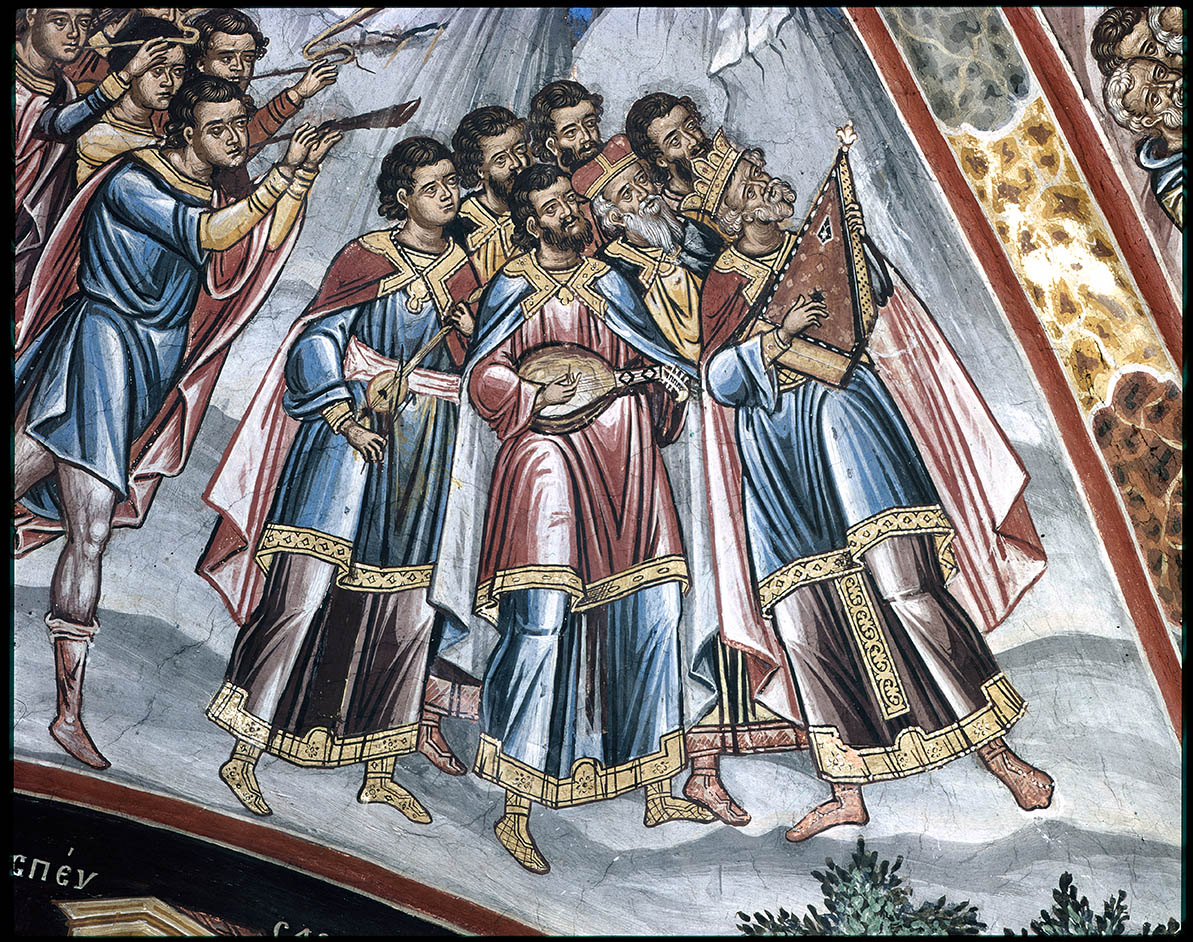
Μουσικές κλίμακες-τρόποι & εναρμόνιση της παραδοσιακής-δημοτικής μουσικής
Το μάθημα εξετάζει τα μουσικά στοιχειά που διαμορφώνουν το θεωρητικό πλαίσιο πρόσληψης και ανάλυσης της ελληνικής παραδοσιακής μουσικής. Αναφέρονται, ενδεικτικά, τα σημαντικότερα κεφάλαια (ή θεματικά πεδία):
- Μουσικά συστήματα της Ανατολικής Μεσογείου
- Ιστορικά χορδίσματα: Φυσικό (Πτολεμαϊκό) και Πυθαγόρειο
- Η επαλληλία των χορδισμάτων στη σημερινή πρακτική
- Συστήματα των 53 και των 72 κομμάτων (θεωρητική βάση της τουρκικής και της βυζαντινής μουσικής) και η συσχέτισή τους με τα ιστορικά χορδίσματα και το ισοσυγκερασμένο χόρδισμα
- Βασικά γένη και μουσική σημειογραφία
- Βασικές κλίμακες/ μακάμ/ ήχοι
- Τονικοί χάρτες μετατροπιών στις βασικές κλίμακες
- Μουσική φόρμα και τονικές αντιθέσεις
- Πρακτικές εναρμόνισης-συσχέτιση με την αστικολαϊκή μουσική και τις τεχνικές της νεοτονικότητας
- Ανάλυση ηχογραφημένου κομματιού ελληνικής παραδοσιακής μουσικής
- Συγγραφή εργασίας ανάλυσης και βιβλιογραφική επιθεώρηση
Συνιστώμενη βιβλιογραφία
Andrikos, Ν. (2018). Οι Λαϊκοί Δρόμοι στο Μεσοπολεμικό Αστικό Τραγούδι: Σχεδίασμα Λαϊκής Τροπικής Θεωρίας. Αθήνα: Τόπος
Aydemir, M. (2012). The Turkish Makam Guide (S. Kompotiati, Trans.). Αθήνα: Fagottobooks
Belaiev, V. & Pring, S.W. (1935). “Turkish Music”, The Musical Quarterly, 21 (3), 356-367
Bozkurt, Β., Yarman, O., Karaosmanoğlu, M.K. & Akkoç, C. (2009). Weighing Diverse Theoretical Modelson Turkish Maqam Music Against Pitch Measurements: A Comparison of Peaks Automatically Derived from Frequency Histograms with Proposed Scale Tones, Journal of New Music Research, 38 (1), 45-70
D’ Erlanger, R. (1930-49). La Musique Arabe. Paris: Geuthner
During, J. & Mirabdholbaghi, Z. (1991). The Art of Persian Music. Washington: Mage
Elsner, J. & Pennanen, R.P. (Eds) (1997). The Structure and Idea of Maqam. Tampere: Tampere University
Farhat, H. (1990). The Dastgāh Concept in Persian Music. New York: Cambridge University Press.
Farraj, J. & Shumays S. A. (2019). Inside Arabic Music: Arabic Maqam Performance and Theory in the 20th Century. New York: Oxford University Press
Fracile, N. (2003). The “Aksak” Rhythm, a Distinctive Feature of the Balkan Folklore, Studia Musicologica Academiae Scientiarum Hungaricae, 44 (1/2), 197-210
Hall, R.W. (2009). Geometrical Models for Modulation in Arabic Music. Philadelphia: Saint Joseph’s University
Manuel, P. (1989). Modal Harmony in Andalusian, Eastern European, and Turkish Syncretic Musics, Yearbook for Traditional Music, 21, 70-94
Marcus, S.L. (1989). Arab Theory in the Modern Period (Doctoral Dissertation). Los Angeles: University of California
____(1992). Modulation in Arab Music: Documenting Oral Concepts, Performance Rules and Strategies. Ethnomusicology, 36 (2), 171-195
____(2007). Music in Egypt: Experiencing Music, Expressing Culture. New York: Oxford University Press.
Mavroidis, M. (1999). Οι Μουσικοί Τρόποι στην Ανατολική Μεσόγειο. Αθήνα: Fagottobooks
Mikosch, T. (2017). Makamlar: The Musical Scales of Turkey. Lulu Press (self-publication of the writer)
Muallem, D. (2010). The Maqam Book: A Doorway to Arab Scales and Modes. Kfar Sava, Israel: OR-TAV Music Publications
Mystakidis, D. (2013). Λαϊκή Κιθάρα – Τροπικότητα και Εναρμόνιση. Θεσσαλονίκη: Πριγκηπέσσα
Nettl, B. & Riddle, R. (1973). Taqsim Nahawand: A Study of Sixteen Performances by Jihad Racy, Yearbook of the International Folk Music Council, 5, 11-50
Öztürk, O.M. (2018). How Was the Traditional Makam Theory Westernized for the Sake of Modernization?, Rast Müzikoloji Dergisi, 6 (1) 1769-1787
Pennanen, R.P. (1997). The Development of Chordal Harmony in Greek Rebetika and Laika Music, 1930s to 1960s, British Journal of Ethnomusicology, 6, 65-116
____(2008). Lost in Scales: Balkan Folk Music Research and the Ottoman Legacy. Musicology, 8, 127-147
Pyrgiotis, D. (2006). Η Αρμονία στην Πράξη (τομ. 2). Αθήνα: Fagottobooks
____(2004). Θησαυρός Μουσικών Κλιμάκων. Αθήνα: Fagottobooks
Samson, J. (2013). Music in the Balkans. Leiden: Brill
Shumays, A.A. (2013). Maqam Analysis: A Primer, Music Theory Spectrum, 35 (2), 235-255
Signell, K.L. (1977). Makam: Modal Practice in Turkish Art Music. Seattle: Asian Music Publications
____(2001). Contemporary Turkish Makam Practice. In V. Danielson, D. Reynolds & S. Marcus (Eds): The Middle East (Garland Encyclopedia of World Music, Vol. 6). New York: Routledge
Simms, R. (2004). The Repertoire of Iraqi Maqamat. Lanham: Scarecrow Press
Skoulios, M. (2014). “Τα ανατολικά Μακάμ και ο «ορθός» τρόπος Ραστ”, Πολυφωνία, 25, 103-126
Spector, J. (1970). Classical Ud Music in Egypt with Special Reference to Maqamat, Ethnomusicology, 14 (2), 243-257
Touma, H. (1971). The Maqam Phenomenon: An Improvisation Technique in the Music of the Middle East, Ethnomusicology, 15, 38-45
____(1995). The Music of the Arabs (new expanded edition). Portland (OR): Amadeus Press
Voulgaris, E. & Vandarakis, V. (2006). Το Αστικό Λαϊκό Τραγούδι στην Ελλάδα του Μεσοπολέμου: Σμυρναίικα και Πειραιώτικα 1922-1940. Αθήνα: Fagottobooks & T.E.I. Hπείρου
Wright, O. (1978). The Modal System of Arab and Persian Music. London: Oxford University Press
Yekta, R. (1922). La Musique Turque. Nous reproduisons, en 4 parties, l’intégralité de son article conacre à la musique turque et publié en Français en 1922. https://www.turquie-culture.fr/pages/arts/musique- turque/yekta-rauf-la-musique-turque-1922-1.html
Yöre, S. (2012). Maqam in Music as a Concept, Scale and Phenomenon, Zeitschrift für die Welt der Türken, 4 (3), 267-286
Zannos, I. (1990). Intonation in Theory and Practice of Greek and Turkish Music, Yearbook for Traditional Music, 22, 42-59